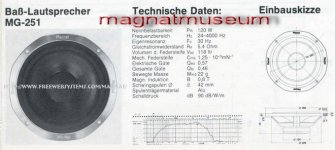How do you go about determining the cabinet volume for a seal enclosure. By this I mean, if I want the cabinet to net 35 hz, how do I determine the cabinet size?
You need to input the Thiele Small parameters into software to model the low frequency response.
WinISD is quite popular - http://www.linearteam.org/
WinISD is quite popular - http://www.linearteam.org/
Bald mathematical equations after Small (not accounting for variable losses, e.g. leakage, damping etc.) and assuming a voltage source amplifier:
Vb = Vas / ([Qtc'/Qts']^2 -1)
Fb = (Qtc'/Qts') * Fs
Where
Vb = box volume
Fb = box tuning
Qts' = Effective Qts (i.e. Qts + series resistance from wire loop, connectors and as relevant passive crossover components)
Qtc' = Effective Qtc (i.e. as calculated using effective Qts).
If the driver isn't capable of 35Hz in a sealed volume, depending on starting Fs, Qts you may be able to force it lower by adding series R if you don't mind burning up power in the resistors, the increased box size, & the reduced sensitivity that comes with it (along with needing to pay attention to heatsinking / dissipation).
An acoustic suspension design is not technically the same thing as a traditional sealed box, nor a Small type alignment. I'm not firing on all cylinders this afternoon, so speaking under correction, but as I recall the bald alignment was Vb = Vas/3 to obtain the desired air-spring effect, which resulted in a Qtc' equal or greater than 2Qts' and an Fb equal or greater than 2Fs.
Vb = Vas / ([Qtc'/Qts']^2 -1)
Fb = (Qtc'/Qts') * Fs
Where
Vb = box volume
Fb = box tuning
Qts' = Effective Qts (i.e. Qts + series resistance from wire loop, connectors and as relevant passive crossover components)
Qtc' = Effective Qtc (i.e. as calculated using effective Qts).
If the driver isn't capable of 35Hz in a sealed volume, depending on starting Fs, Qts you may be able to force it lower by adding series R if you don't mind burning up power in the resistors, the increased box size, & the reduced sensitivity that comes with it (along with needing to pay attention to heatsinking / dissipation).
An acoustic suspension design is not technically the same thing as a traditional sealed box, nor a Small type alignment. I'm not firing on all cylinders this afternoon, so speaking under correction, but as I recall the bald alignment was Vb = Vas/3 to obtain the desired air-spring effect, which resulted in a Qtc' equal or greater than 2Qts' and an Fb equal or greater than 2Fs.
Last edited:
The driver is a Magnat MG-251, this is a foam surround driver from the 80’s. I’ve had these around for years and thought they may be ideal for a project of this kind.What driver?
dave
Attachments
Looks like the most common choice would be about 80 litres. Do note that the actual volume is not super critical.

dave
dave
Here you can read a little about aucustic supension.
https://www.audioholics.com/loudspeaker-design/acoustic-suspensionAs mentioned, not the same as a sealed box. Even if it is sealed.
https://www.audioholics.com/loudspeaker-design/acoustic-suspensionAs mentioned, not the same as a sealed box. Even if it is sealed.
An acoustic suspension box is sealed. A Sealed box is not necessarily an acoustic suspension.
But given how we model drivers these days, the difference is moot. The difference would be buried in the T/S and we don’t have to worry about the distinction.
Fom plugs in a vent are unlikely to seal the box, just push it toward saperiodic and if the amount is sufficient are converted inrto aperiodic (or close enuff for the purpose)
dave
But given how we model drivers these days, the difference is moot. The difference would be buried in the T/S and we don’t have to worry about the distinction.
Fom plugs in a vent are unlikely to seal the box, just push it toward saperiodic and if the amount is sufficient are converted inrto aperiodic (or close enuff for the purpose)
dave
- Home
- Loudspeakers
- Multi-Way
- Acoustic suspension
